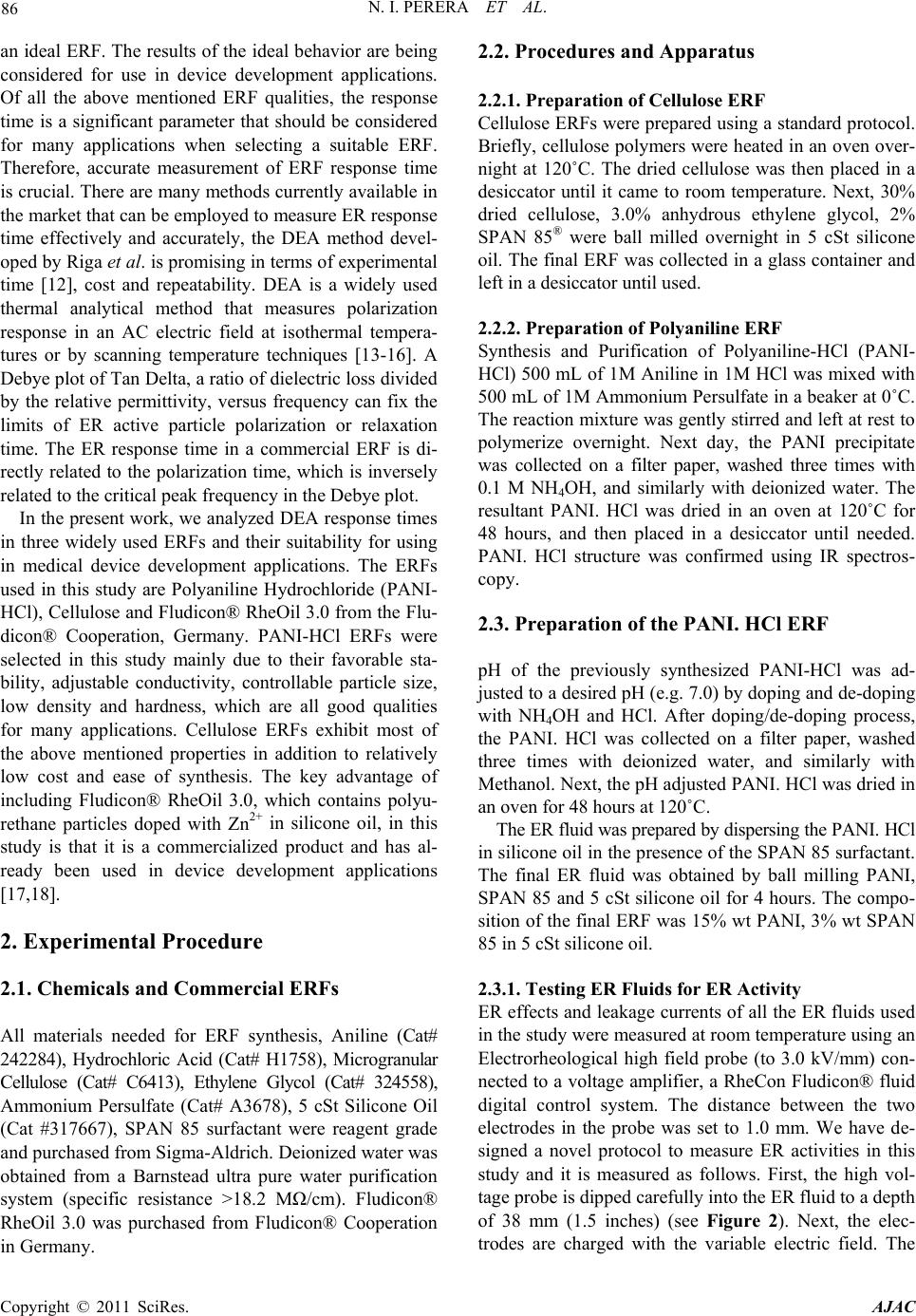
N. I. PERERA ET AL.
Copyright © 2011 SciRes. AJAC
an ideal ERF. The results of the ideal behavior are being
considered for use in device development applications.
Of all the above mentioned ERF qualities, the response
time is a significant parameter that should be considered
for many applications when selecting a suitable ERF.
Therefore, accurate measurement of ERF response time
is crucial. There are many methods currently available in
the market that can be employed to measure ER response
time effectively and accurately, the DEA method devel-
oped by Riga et al. is promising in terms of experimental
time [12], cost and repeatability. DEA is a widely used
thermal analytical method that measures polarization
response in an AC electric field at isothermal tempera-
tures or by scanning temperature techniques [13-16]. A
Debye plot of Tan Delta, a ratio of d ielectric los s divided
by the relative permittivity, versus frequency can fix the
limits of ER active particle polarization or relaxation
time. The ER response time in a commercial ERF is di-
rectly related to the polarization time, which is inversely
related to the critical peak frequency in the Debye plot.
In the present work, we analyzed DEA response times
in three widely used ERFs and their suitability for using
in medical device development applications. The ERFs
used in this study are Polyaniline Hydrochloride (PANI-
HCl), Cellulose and Fludicon® RheOil 3.0 from the Flu-
dicon® Cooperation, Germany. PANI-HCl ERFs were
selected in this study mainly due to their favorable sta-
bility, adjustable conductivity, controllable particle size,
low density and hardness, which are all good qualities
for many applications. Cellulose ERFs exhibit most of
the above mentioned properties in addition to relatively
low cost and ease of synthesis. The key advantage of
including Fludicon® RheOil 3.0, which contains polyu-
rethane particles doped with Zn2+ in silicone oil, in this
study is that it is a commercialized product and has al-
ready been used in device development applications
[17,18].
2. Experimental Procedure
2.1. Chemicals and Commercial ERFs
All materials needed for ERF synthesis, Aniline (Cat#
242284), Hydrochloric Acid (Cat# H1758), Microgranular
Cellulose (Cat# C6413), Ethylene Glycol (Cat# 3 24558),
Ammonium Persulfate (Cat# A3678), 5 cSt Silicone Oil
(Cat #317667), SPAN 85 surfactant were reagent grade
and purcha s ed from Sigma-Aldrich. Deionized water was
obtained from a Barnstead ultra pure water purification
system (specific resistance >18.2 MΩ/cm). Fludicon®
RheOil 3.0 was purchased from Fludicon® Cooperation
in Germany.
2.2. Procedures and Appa ratus
2.2.1. Preparation of Cellulose ERF
Cellulose ERFs were prepared using a standard protocol.
Briefly, cellulose polymers were heated in an oven over-
night at 120˚C. The dried cellulose was then placed in a
desiccator until it came to room temperature. Next, 30%
dried cellulose, 3.0% anhydrous ethylene glycol, 2%
SPAN 85® were ball milled overnight in 5 cSt silicone
oil. The final ERF was collected in a glass container and
left in a desiccator until used.
2.2.2. Preparation of Polyaniline ERF
Synthesis and Purification of Polyaniline-HCl ( PA NI-
HCl) 500 mL of 1M Aniline in 1M HCl was mixed with
500 mL of 1M Ammo nium Persulfate in a beaker at 0˚C.
The reaction mixture was gently stirr ed and left at rest to
polymerize overnight. Next day, the PANI precipitate
was collected on a filter paper, washed three times with
0.1 M NH4OH, and similarly with deionized water. The
resultant PANI. HCl was dried in an oven at 120˚C for
48 hours, and then placed in a desiccator until needed.
PANI. HCl structure was confirmed using IR spectros-
copy.
2.3. Preparation of the PANI. HCl ERF
pH of the previously synthesized PANI-HCl was ad-
justed to a desired pH (e.g. 7.0) by doping and d e-doping
with NH4OH and HCl. After doping/de-doping process,
the PANI. HCl was collected on a filter paper, washed
three times with deionized water, and similarly with
Methanol. Next, the pH adjusted PANI. HCl was dried in
an oven for 48 hours at 120˚C.
The ER fluid was prepared by dispersing the PANI. HCl
in silicone oil in the presence of the SPAN 85 surfactant.
The final ER fluid was obtained by ball milling PANI,
SPAN 85 and 5 cSt silicone oil for 4 hours. The compo-
sition of the final ERF was 15% wt PANI, 3% wt SPAN
85 in 5 cSt silicone oil.
2.3.1. Testing ER Fluids for ER Activity
ER effects and leakage currents of all the ER fluids used
in the study were measured at room temperature using an
Electrorheological high field probe (to 3.0 kV/mm) con-
nected to a voltage amplifier, a RheCon Fludicon® fluid
digital control system. The distance between the two
electrodes in the probe was set to 1.0 mm. We have de-
signed a novel protocol to measure ER activities in this
study and it is measured as follows. First, the high vol-
tage probe is dipped carefully into the ER fluid to a depth
of 38 mm (1.5 inches) (see Figure 2). Next, the elec-
trodes are charged with the variable electric field. The